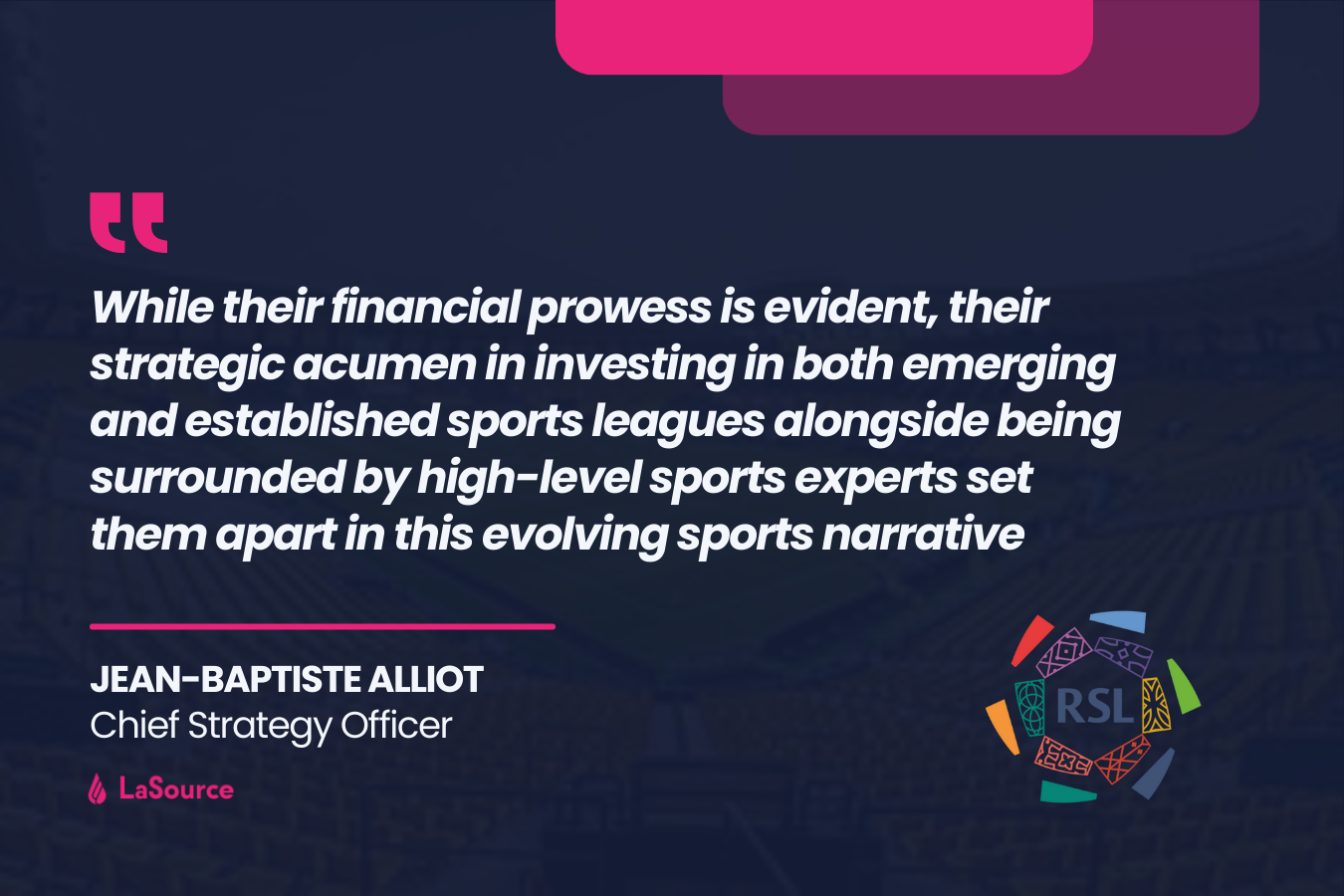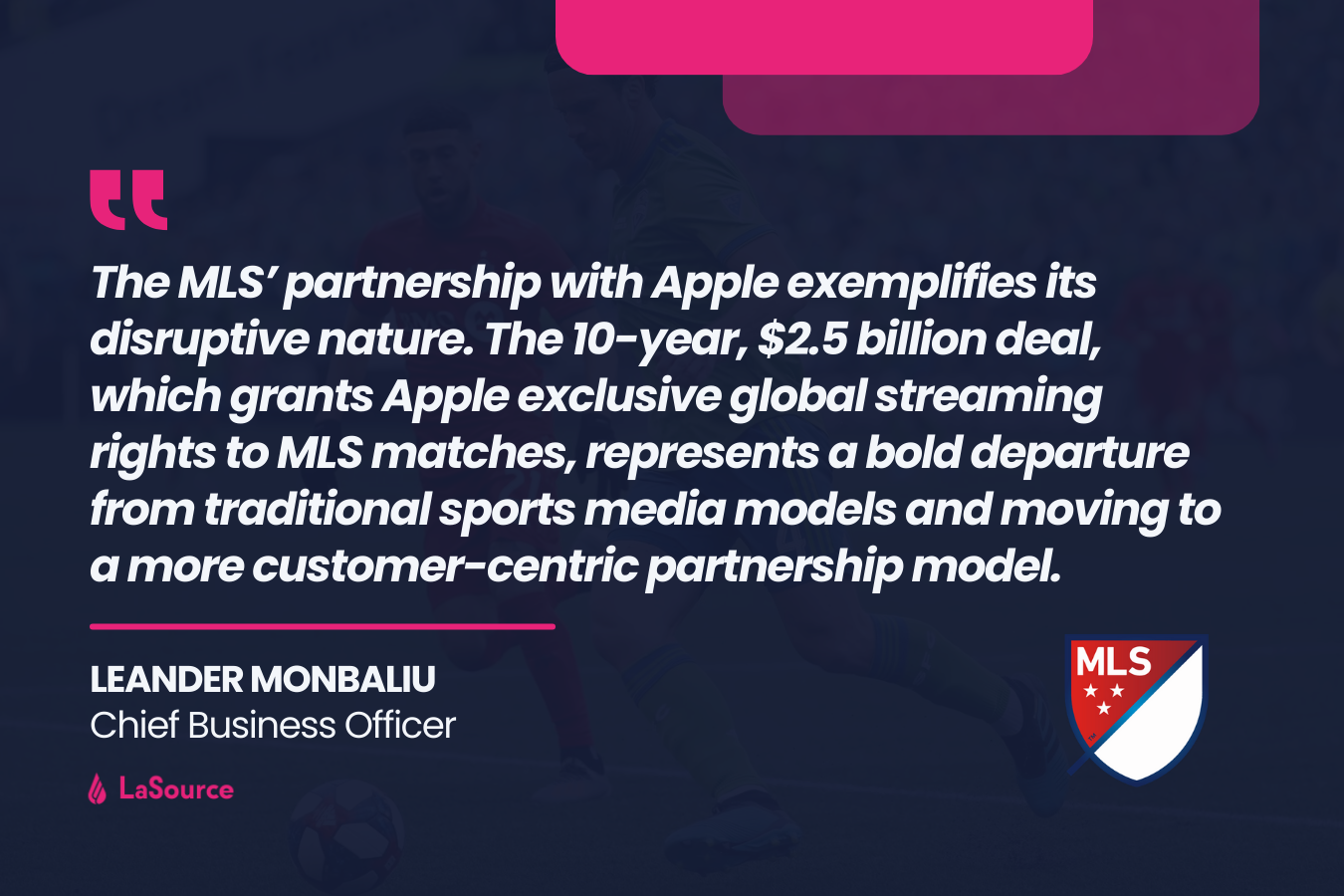LaSource's Picks: Sport Disruptors of 2023
2023 unfolded as a transformative year for the sports industry, where innovation clashed with tradition. The industry grappled with technological advancements and changing consumer behaviors that posed considerable challenges to traditional actors like leagues, clubs & broadcasters.
Amidst these challenges, innovative players emerged with disruptive initiatives, introducing new sports formats such as the King's League and 3 x 3 Basketball, signalling a departure from traditional sports formats. Simultaneously, the media rights landscape underwent diversification, notably within major European sports leagues. Private equity investments from the Middle East region played a pivotal role as well, emphasizing the unsustainability of the traditional business model employed by rights holders.
These shifts underscored the centrality of an innovation strategy in navigating the evolving sports landscape. At LaSource, we have actively expanded our consultancy services to assist clients in adapting to these dynamic disruptions. In our latest piece, our leadership team reflects on the standout disruptors of 2023, delving into their choices and envisioning the potential impact. Dive into the article to gain insights into the transformative year that was.
David Gonçalves, Chief Operating Officer - PREMIER PADEL’s Accessibility for Players and Fans
What organization within the sports industry do you consider to be a notable disruptor?
The World Padel Tour and the game of Padel itself have gained significant traction in the sports industry, presenting a disruptive force that I, both as a practitioner and a fan, consider noteworthy for several reasons.
How has their presence affected or shaped the sports industry?
For Practitioners of Padel:
Padel is more accessible than many traditional racquet sports like tennis. Padel courts require less space and are less expensive to construct (Between two and three times less expensive), making it easier for clubs and communities to adopt the sport. Padel stands out for its adaptability to urban environments with limited space, as its smaller court size and utilization of walls allow it to be played in locations where traditional tennis courts might not be feasible.
Moreover, Padel has a relatively low learning curve compared to other racquet sports. The rules are straightforward, and beginners can quickly grasp the fundamentals, which helps in attracting new players and casual fans. The sport has gained popularity among a diverse demographic, attracting players of various ages and skill levels. This social aspect makes it appealing to many players, including those who may not have been drawn to individual sports. This inclusivity has contributed to its widespread acceptance and growth.
Perception of Fans:
From a fan/spectator perspective, Padel is known for its dynamic and fast-paced nature. The ball frequently hits the walls, leading to longer rallies and more engaging gameplay. The entertainment factor has significantly contributed to the sport’s popularity among spectators.
The upcoming merger of Premier Padel with World Padel Tour for the next season not only underscores the current structure of the sport but also enhances its credibility. This development attracts a greater influx of players and sponsors, fostering the growth of padel as a competitive sport. With both Premier Padel and WPT boasting a global presence and making successful forays into markets where padel is not yet well-established, the sport emerges as a disruptor in territories where it is a relatively new phenomenon.
The engagement of celebrities and endorsements has significantly elevated the profile of padel. The participation and promotion of influential figures in the sport have effectively heightened its visibility and generated increased interest.
What lessons can sports organisations derive from their example?
Sports organisations can draw valuable lessons from the success of Padel. Padel's ability to create an engaging, inviting, and inclusive environment, facilitated by smaller courts and lower costs, makes it attractive for clubs and communities. The sport's easy learning curve and broad demographic appeal contribute to inclusivity, bringing together players of various backgrounds. The dynamic nature of Padel, marked by frequent wall interactions, enhances spectator engagement, with entertained fans more likely to become engaged and, ultimately, lifelong fans.
Jean Baptiste - Alliot: Saudi Arabia and the Middle East’s Rise to Prominence
What organisation within the sports industry do you consider to be a notable disruptor?
Beyond a mere interest in sports, Saudi Arabias’s influence extends globally, coinciding with macroeconomic shifts, including changing interest policies and rising costs. As a major revenue source in the market, they are positioned to make a substantial impact.
How has their presence affected or shaped the sports industry?
As a major revenue source in the market, they are positioned to make a substantial impact. Emphasizing a long-term perspective, their strategic approach is evident in endeavors such as high profile football signings and restructuring the golf landscape by overshadowing PGA. Their entrance into UFC, boxing, and Formula One underscores a comprehensive strategy aimed at shaping the sports landscape for the next 10 to 15 years, preparing for a post-oil economy.
With two trillion in reserves, their influence is undeniable, marking a pivotal moment in the trajectory of sports organizations, agencies, and leagues, all converging for financial opportunities. While their financial prowess is evident, their strategic acumen in investing in both emerging and established sports leagues sets them apart in this evolving sports narrative.
A couple of years ago, the predominant focus in the sports industry was on the top line—acquiring new customers, especially in media rights and sponsorships. However, the profitability aspect, the bottom line, was largely overlooked. The landscape has since evolved, recognising sports as an expensive asset.
The influx of money, particularly from the Middle East, and the young demographics in Africa and next to India have altered the sports industry's geography. While Europe and North America remain central, Europe's traditional business model faces challenges. Entities like ESPL and PIF have emerged as key players, impacting the sports industry by reshaping business strategies. Their influence extends to ventures like PGA and golf, prompting discussions about the structure of prestigious tournaments like the Champions League.
As well, they are unconstrained by limits, they shape the future of competitions and rights deals. Their approach involves aggregation and a comprehensive influence that positions them as the driving force in the evolving sports business landscape.
What lessons can sports organisations derive from their example?
Anticipating competitors and future-proofing: Over time, various players have emerged in the sports industry, with China and other regions taking the spotlight. While Europe and North America remain strong, a shift in business strategy is evident. This involves attracting top talent, forming joint ventures with tech companies, and initiatives like World Padel in Qatar. The approach extends beyond acquiring assets, focusing on building a comprehensive tech ecosystem and transforming the industry. They have snuck their way into this industry by attacking weak points and opportunities to innovate where other organisations have remained stagnant.
Long term orientation: The strategy spans a 10 to 15-year journey, drawing in people and fostering innovation. This presents both opportunities and threats for sports organisations. The cautionary tale of the PGA shows that resistance may lead to partnerships or takeovers. Tier-two sports organisations face a dilemma – collaborate for growth or risk new players creating competition.
In essence, it's a dual situation – an opportunity for collaboration or a threat if not handled wisely. Observing how these new entrants operate reveals a focus on strategic planning. While financial power facilitates these endeavours, the emphasis lies on creating centralised league services, adopting best practices, and surrounding themselves with key individuals. The key takeaway is that having money alone is not enough; it requires intelligent and organized implementation in the dynamic world of sports.
Samuel Westberg - The European League of Football’s Merged Growth Strategy.
What organisation within the sports industry do you consider to be a notable disruptor?
The European League of Football is navigating a path that blends a cost-effective European mindset with the centralised approach typical of American sports models.
How has their presence affected or shaped the sports industry?
The European League of Football is trying to promote a North America - dominated sport where the biggest league in the world (NFL) has failed to implement itself in Europe so far. I believe one of the key objectives for a sport to develop itself in a sustainable way is grassroots, and the fact of having local teams, that you can see Live rather than on video highlights only, will be an important element for the growth of the sport.
The proposed method involves a gradual and measured development strategy, aligning with a European mindset of cautious progression and the reality of the current economy, which I think can work here. This approach aims to build a sustainable foundation for the sport's growth, emphasising responsible spending.
The centralised approach, a preference shared by us at LaSource, is also an important factor of the way the EFL are going about the development of the league and its franchises. (Leagues should be taking the lead) As an example focusing on digital, this benefits newly formed teams such as the Paris Musketeers to actually have a good output, both in terms of social media strategy and having a convenient first web platform with simple access to information and merch for example.
The strategic targeting of a unique time slot—summer—sets the European League of Football apart from other competitions. Although this timing presents challenges, it represents a relatively unoccupied period, offering an opportunity to capture the interest of potential American football enthusiasts.
What lessons can sports organisations derive from their example?
Evaluating the path to success: The European League of Football has effectively analyzed successful and unsuccessful elements, demonstrating a keen understanding of the European sports landscape. They have crafted a model with a centralized approach that goes beyond investing solely in athletes, as evidenced by the relatively low salaries for franchise athletes. This holistic strategy positions the league for sustained success. I am not 100% sure American Football has a chance of making it but if I had to go about developing it, I don’t think I would have done things much differently.
Leander Monbaliu: MLS’ media rights disruption
What organisation within the sports industry do you consider to be a notable disruptor?
MLS, specifically their recent media rights agreement focused on aggregation in a fragmented media rights market.
How has their presence affected or shaped the sports industry?
The MLS partnership with Apple exemplifies its disruptive nature. The 10-year, $2.5 billion deal, which grants Apple exclusiveglobal streaming rights to MLS matches, represents a bold departure from traditional sports media models and moving to a more customer-centric partnership model. This is demonstrated by several key characteristics of the deal:
The first key takeaway is global. In a media rights market concentrated on fragmentation, the MLS centers their rights deal around aggregation. Fans and consumers know where to find this product regardless of geographical location, and this deal has done something others have not: made it easy for the consumer to find and watch all of the games. Especially for a challenger product, this product-market fit is key.
The next is the length of the deal, the MLS focuses on a long-term, mutually beneficial partnership between themself and Apple. The partnership extends beyond mere streaming rights. Apple is actively involved in enhancing the MLS fan experience, introducing features like interactive replays, augmented reality overlays, and personalized content recommendations. The fact that the league can speak to only one broadcast partner - and not many competing broadcasters - combined with the long-term relationship, allows for deeper conversations, data sharing and overall a move away from the traditional “take the money and run”- approach.
MLS's centralised approach to media rights and technology adoption has also set it apart from other sports leagues. By taking control of its own distribution, MLS has greater flexibility in tailoring its content and delivery to specific markets and fan preferences. This centralised strategy provides a framework for other leagues to consider as they navigate the evolving media landscape.
The league's further expansion into smaller markets and ability to attract top-tier talent with Miami and the signing of football icon Lionel Messi, further demonstrates its willingness to challenge the status quo. MLS's ability to attract global stars like Messi speaks volumes about its growing appeal and breakout nature.
What lessons can sports organisations derive from their example? (Discover how leagues could be taking the lead)
Embrace partnership opportunities: MLS's partnership with Apple demonstrates the power of collaboration in driving innovation and expanding reach. Sports organisations should explore similar partnerships to tap into new audiences, expertise, experiences for fans and distribution channels. The MLS is focused on bringing together and fostering a strong relationship with stakeholders involved in making the business side a success. Especially in more challenging times, organisations that embrace this ecosystem thinking will prove to be most resilient.
Consider centralised approach: MLS's centralised approach to media rights provides greater control over distribution and revenue generation. This model is successful in the US due to their league structure. However, sports organisations should evaluate whether a centralised strategy aligns with their goals and market conditions and build a sound strategy to allow the league to take the lead in creating a better product for the fans while helping all stakeholders to drive and diversify revenues.
At LaSource, we provide sports organisations with tailored, business-driven strategies to anticipate the future, professionalise and ensure growing revenues in a rapidly changing landscape. Explore our extensive list of services for sports organisations (Our Services)









